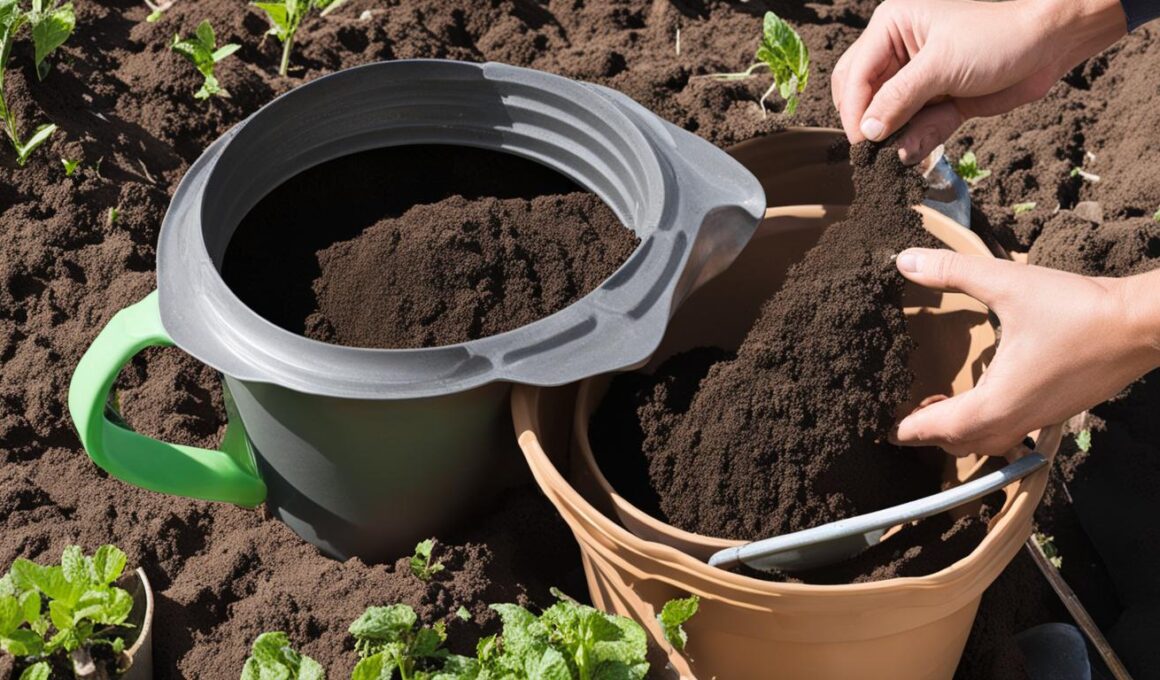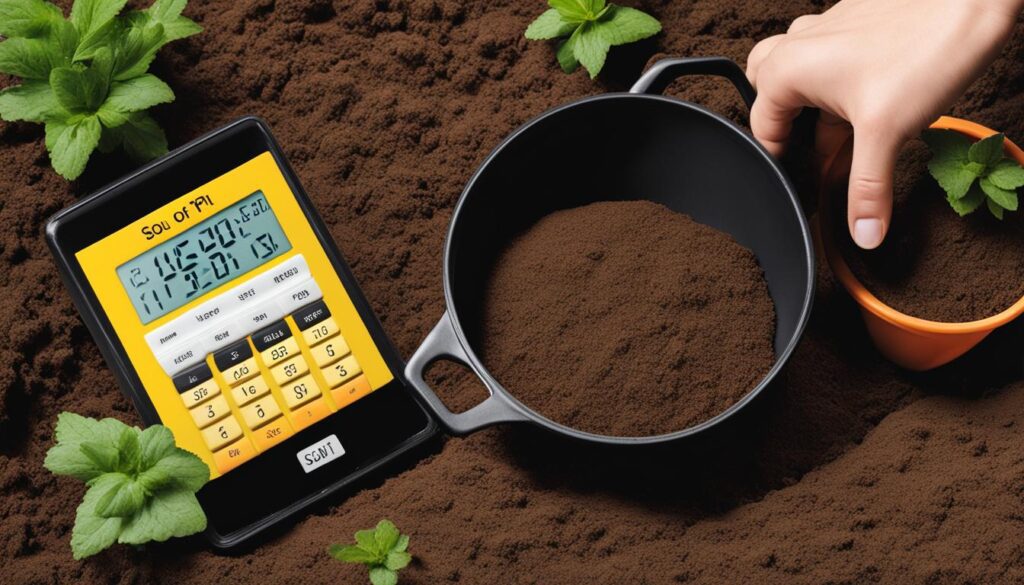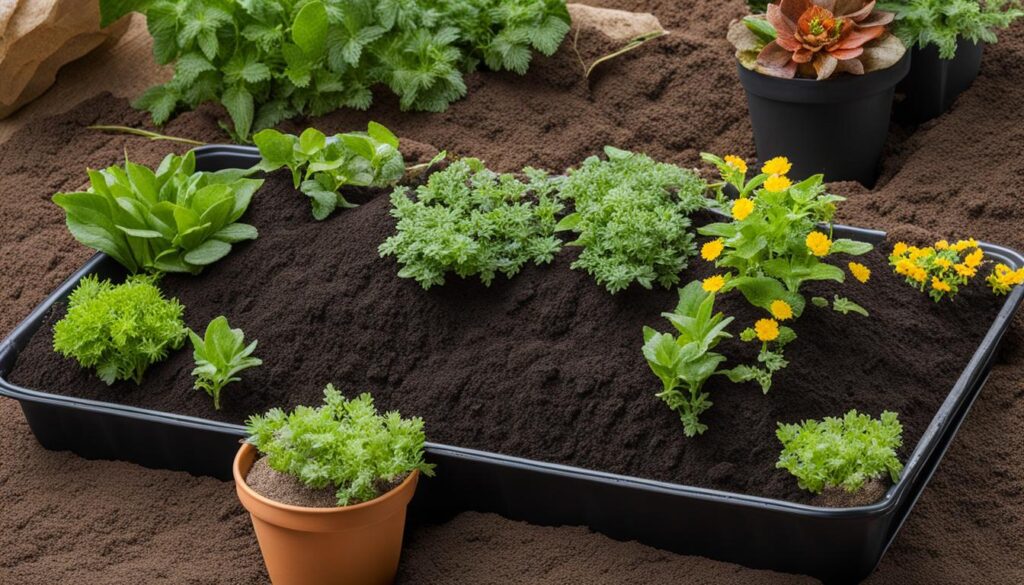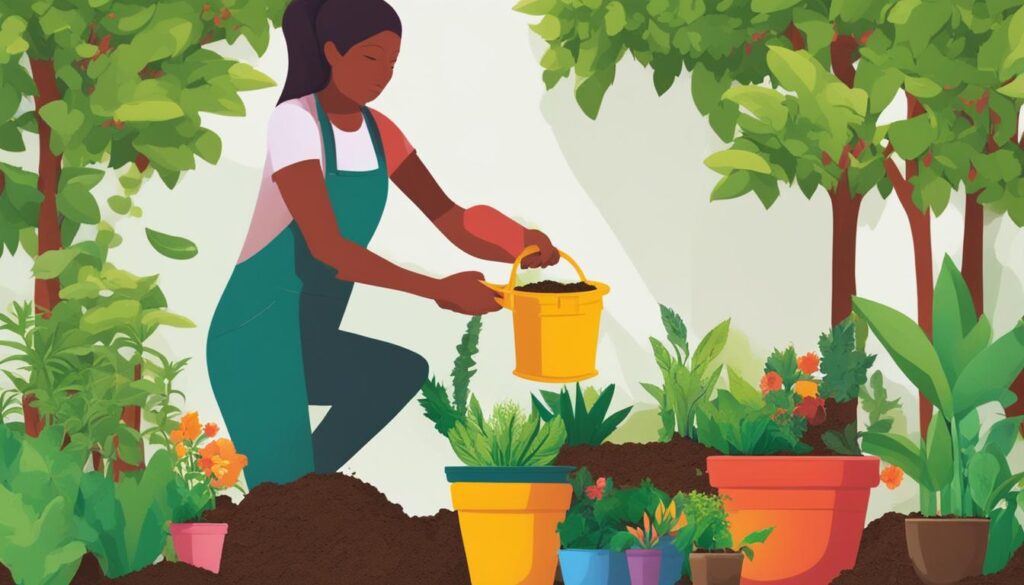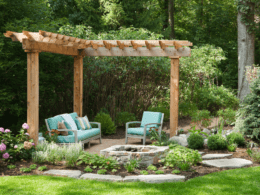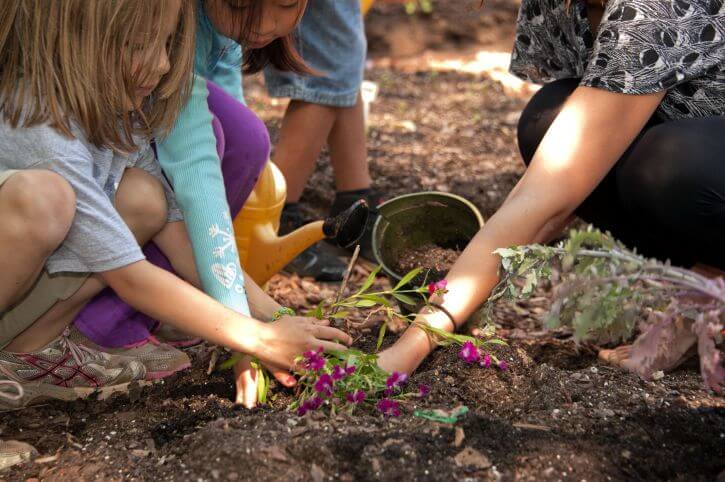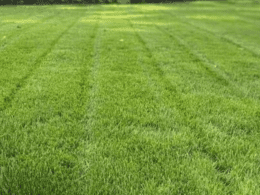When using a 5-gallon pot for container gardening, it’s essential to know the precise amount of soil you need to ensure healthy plant growth. The volume of soil required to fill a 5-gallon pot is approximately 0.7 cubic feet. This measurement is based on the standard size of a 5-gallon pot, which typically has a diameter of 10¾ inches and a height of 11 inches.
It’s important to use a high-quality soil mix consisting of compost, perlite, coconut coir or peat moss, and vermiculite to provide proper water retention, aeration, and nutrition for your plants. By following these guidelines, you can achieve optimal results with your container gardening efforts.
Key Takeaways:
- Knowing the amount of soil needed for a 5-gallon pot is crucial for successful container gardening.
- The volume of soil required is approximately 0.7 cubic feet.
- Use a high-quality soil mix with compost, perlite, coconut coir or peat moss, and vermiculite for optimal plant growth.
- Proper water retention, aeration, and nutrition are essential for healthy plants in containers.
- Follow the recommended guidelines to achieve the best results with your container gardening endeavors.
How to Calculate Soil Needs for Different Container Sizes
When it comes to container gardening, it’s important to calculate the right amount of soil needed for different container sizes. By understanding how to measure soil requirements, you can ensure your plants have the optimal conditions for their growth. Using a soil calculator for pots can be a useful tool in determining the appropriate amount of soil to use for various container sizes.
Measuring soil mix for different gallon sizes follows a general guideline. For smaller containers, such as 1 or 2-gallon pots, you can estimate that they require approximately 0.15 cubic feet of soil. This estimation increases as the container size gets larger. For example, a 10-gallon pot may require around 0.7 cubic feet of soil, similar to a 5-gallon pot. It’s essential to adjust the soil amount accordingly to provide adequate space for root growth and proper nutrient availability.
When using a soil calculator for pots, take into account the dimensions of the container, such as its diameter and height. These measurements can help you determine the volume of soil needed. Additionally, consider the specific requirements of the plants you’re growing. Some plants may require more soil depth than others, so be sure to research the specific needs of your chosen plants.
Table: Soil Requirements for Different Container Sizes
| Container Size (Gallons) | Approximate Soil Volume (Cubic Feet) |
|---|---|
| 1 | 0.15 |
| 2 | 0.15 |
| 3 | 0.3 |
| 5 | 0.7 |
| 10 | 0.7 |
| 15 | 1.2 |
Keep in mind that these measurements are approximate and may vary depending on factors such as the type of soil used, the specific needs of your plants, and the desired amount of soil depth for optimal growth. It’s always a good idea to have some extra soil on hand to top up containers as needed.
By understanding how to calculate soil needs for different container sizes and utilizing a soil calculator for pots, you can ensure your container garden has the right amount of soil for successful plant growth. Providing adequate soil volume allows for proper root development, nutrient availability, and moisture retention. With careful measurement and consideration of your plants’ needs, you’ll be on your way to creating a thriving container garden.
The Best Soil Mix for Container Gardening
When it comes to container gardening, choosing the right soil mix is crucial for the success of your plants. Potting soil or potting mix is the best choice for container gardening as it provides the necessary nutrients, water retention, and aeration for healthy plant growth. Look for a potting mix that has a loose and lightweight texture and includes ingredients such as compost, perlite, coconut coir or peat moss, and vermiculite. These components will ensure proper nutrient availability, drainage, and oxygen circulation for your plants. Additionally, consider organic potting soil options that are suitable for both indoor and outdoor gardening.
Using a high-quality potting soil mix offers several benefits for your container garden. Firstly, it provides the essential nutrients that your plants need to thrive. The compost and organic matter in the mix release nutrients slowly over time, ensuring a steady supply for your plants’ growth. Secondly, a good potting mix retains water effectively, keeping your plants adequately hydrated. The coconut coir or peat moss in the mix helps to retain moisture while also providing good drainage to prevent overwatering. This balance is crucial for preventing root rot and allowing oxygen to reach the roots. Lastly, the lightweight and airy texture of a quality potting mix improves aeration, allowing the roots to breathe and preventing compacted soil.
When selecting a potting soil mix for your container garden, be sure to check the ingredients list and choose a reputable brand. Look for mixes that are labeled specifically for container gardening or indoor plants as they will have the right balance of nutrients and drainage properties. Avoid using garden soil or topsoil in containers as they can be too heavy and compact, leading to drainage issues and root suffocation.
Benefits of Using the Right Soil Mix:
- Provides essential nutrients for healthy plant growth
- Retains water effectively while maintaining good drainage
- Improves aeration and prevents compacted soil
- Reduces the risk of root rot and suffocation
- Suitable for both indoor and outdoor container gardening
Important Ingredients in Potting Soil Mix:
| Ingredient | Function |
|---|---|
| Compost | Provides nutrients and improves soil structure |
| Perlite | Enhances drainage and aeration |
| Coconut Coir or Peat Moss | Retains moisture and improves water retention |
| Vermiculite | Improves water retention and aeration |
By using the best soil mix for your container gardening, you can create an optimal environment for your plants to thrive. Remember to choose a potting soil mix that includes the necessary ingredients for proper nutrition, water retention, and aeration. With the right soil mix, your container garden will flourish with healthy and vibrant plants.
Soil Requirements for Different Container Sizes
When it comes to container gardening, understanding the soil requirements for different container sizes is essential for the healthy growth of your plants. The volume of soil you need will vary depending on the size of your container. Here is a guide to help you determine the soil requirements for various gallon sizes:
1. 1-Gallon Container
For a 1-gallon container, you will generally need approximately 0.13 cubic feet of soil. This size of container is suitable for small plants or seedlings.
2. 3-Gallon Container
A 3-gallon container typically requires around 0.4 cubic feet of soil. This size is suitable for medium-sized plants that require more space for root development.
3. 7-Gallon Container
For a 7-gallon container, you will need approximately 0.9 cubic feet of soil. This size is ideal for larger plants or those that have a more extensive root system.
4. 10-Gallon Container
A 10-gallon container will generally require about 1.3 cubic feet of soil. This size of container is suitable for large plants or those that require ample space for root growth.
5. 15-Gallon Container
For a 15-gallon container, you will need approximately 1.9 cubic feet of soil. This size is ideal for plants that require even more space for their root system.
6. 20-Gallon Container
A 20-gallon container typically requires around 2.5 cubic feet of soil. This size is suitable for large plants or those that have a particularly extensive root system.
7. 25-Gallon Container
For a 25-gallon container, you will generally need about 3.1 cubic feet of soil. This size is ideal for plants that require a significant amount of space for their roots.
These guidelines offer a starting point for determining the soil requirements for different container sizes. Keep in mind that there may be variations based on the specific dimensions and shape of your containers. Adjusting the amount of soil accordingly will help ensure optimal plant growth and development.
Continue reading to learn more about essential tips for successful container gardening.
Tips for Successful Container Gardening
Container gardening offers a convenient and versatile way to grow plants, whether you have limited space, want to beautify your patio, or simply enjoy the flexibility of movable gardens. To ensure the success of your container gardening endeavors, follow these helpful tips:
- Choose the right container: Select containers that have adequate drainage holes to prevent waterlogging and ensure proper oxygen circulation. Consider the size of the plants you intend to grow and choose containers that provide enough room for root development.
- Select the right soil mix: Use a high-quality potting mix that provides the necessary nutrients, water retention, and aeration for healthy plant growth. Look for mixes that contain a combination of compost, perlite, coconut coir or peat moss, and vermiculite for optimal results.
- Water appropriately: Container plants may require more frequent watering than plants in the ground due to limited soil volume. Check the moisture levels regularly and water when the top inch of soil feels dry. Avoid overwatering, as it can lead to root rot.
- Provide adequate sunlight: Most plants require at least 6 hours of direct sunlight each day. Place your containers in a location that receives the appropriate amount of sunlight for the specific plants you are growing.
- Fertilize regularly: Container-grown plants may require more frequent fertilization compared to those in the ground. Use a balanced, slow-release fertilizer or organic alternatives to provide essential nutrients for healthy growth.
- Monitor for pests and diseases: Inspect your plants regularly for signs of pests or diseases. Early detection allows for prompt treatment and prevents further damage.
- Rotate your plants: To prevent root-bound plants and maintain balanced growth, rotate the containers periodically. This allows all sides of the plant to receive equal sunlight and prevents one side from becoming stunted.
By following these tips, you can create a thriving container garden filled with beautiful and healthy plants. Experiment with different plant varieties and combinations to add color and texture to your outdoor or indoor space. Enjoy the rewards of your efforts as you watch your container garden flourish throughout the seasons.
Table: Essential Tools for Container Gardening
| Tool | Description |
|---|---|
| Garden trowel | A small handheld tool for digging and transferring soil or plants into containers. |
| Hand pruners | Used for trimming and pruning plants to maintain their shape and promote healthy growth. |
| Watering can or hose attachment | Allows for controlled watering of container plants, ensuring proper hydration without overwatering. |
| Plant labels | Helps keep track of plant varieties and care instructions, especially when growing multiple plants in containers. |
| Support stakes or trellises | Used to provide support for climbing plants or those with weak stems. |
| Pruning shears | Similar to hand pruners but designed for larger branches or tougher plants. |
What is the Difference in Soil Volume Needed for Different Size Containers?
The amount of soil required for different size containers varies, depending on the specific needs of your plants. When using a grow bag, such as for container gardening, you may wonder how much soil for grow bag is needed. The size of the container determines the depth of the root system and the overall volume of soil necessary to provide adequate nutrients and moisture for optimal plant growth.
Conclusion
Container gardening offers a versatile and space-efficient way to grow plants. Understanding the soil requirements for different container sizes, such as a 5-gallon pot, is crucial for achieving successful plant growth. By following proper soil measurements and using a high-quality soil mix, you can provide your plants with the necessary nutrients, water retention, and aeration they need to thrive.
Remember to consider other factors like proper drainage, appropriate container size, and regular maintenance to ensure the overall health and vitality of your container garden. With these guidelines in mind, you’re ready to embark on your container gardening journey and enjoy the rewards of vibrant and flourishing plants.
Key takeaways:
- When using a 5-gallon pot, you’ll need approximately 0.7 cubic feet of soil for optimal plant growth.
- Choose a high-quality soil mix consisting of compost, perlite, coconut coir or peat moss, and vermiculite for proper water retention, aeration, and nutrition.
- Adjust the amount of soil for different container sizes using general guidelines.
- Potting soil is the best choice for container gardening as it provides the necessary nutrients, water retention, and aeration.
- Consider organic potting soil options suitable for both indoor and outdoor gardening.
With these key takeaways and your newfound knowledge, you can confidently nurture your container garden and enjoy the beauty and abundance it will bring to your space.
FAQ
How much soil do I need for a 5-gallon pot?
The volume of soil required to fill a 5-gallon pot is approximately 0.7 cubic feet.
What is the best soil mix for container gardening?
The best soil mix for container gardening is potting soil or potting mix, which provides the necessary nutrients, water retention, and aeration for healthy plant growth.
How do I calculate soil needs for different container sizes?
Depending on the size of your container, you may need to adjust the amount of soil accordingly. Here are some general guidelines:
What are the soil requirements for different container sizes?
Here are the soil mix requirements for various gallon sizes:
What are some tips for successful container gardening?
Here are some tips to help you succeed with your container gardening endeavors:





